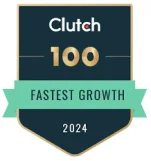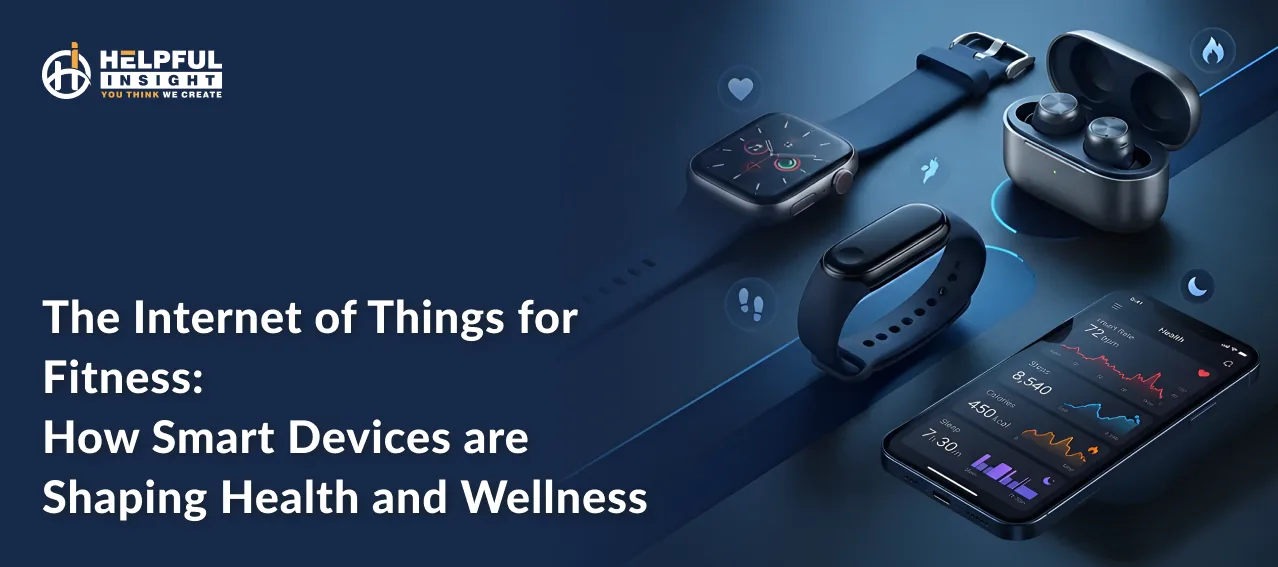We all can agree that a phone has become much more than a device used for communicating – it’s your coach, cheerleader, and fitness buddy. Well, This statement is true for 150 million users thanks to Fitness App Like Strava, which blends workout tracking with networking. Not only this, you can record personal best or and share your morning run or other activities with friends. Fitness Tracking App like Strava have become the go-to for activity tracking and staying connected in a community where motivation and personal achievements thrive.
As the fitness tech market is booming, now’s the best time to develop something revolutionary. But creating an app like Strava isn’t a normal tracker but has a community, delivers smart insights, and designs an experience people love. Before we move, here are few statistics that you might be interested in:
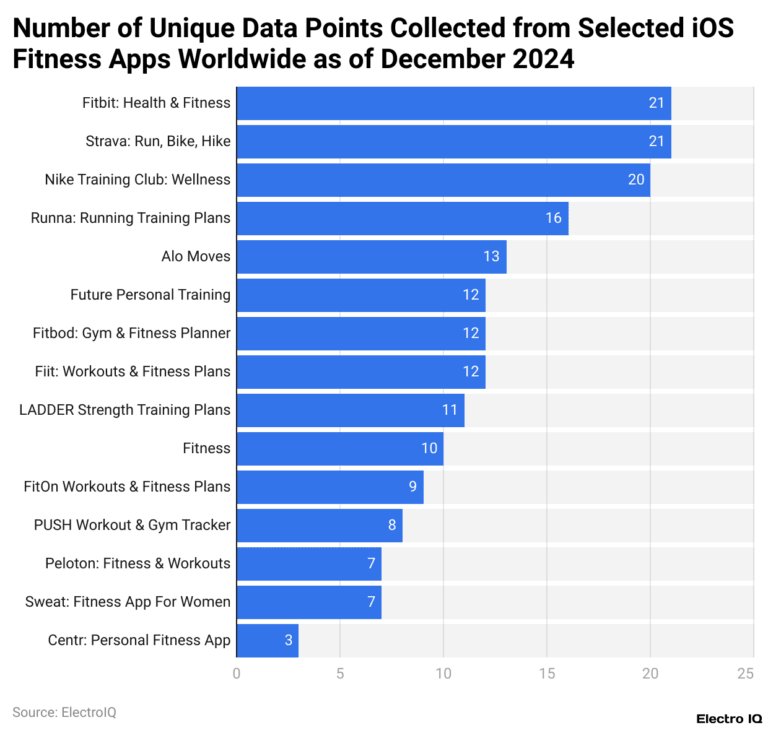
- Strava logged around 220 workout hours in 2024, of which 169 hours were of High Intensity Training Workout and approximately 372 km was converted through running or jogging.
- This calculated to 227 active days meaning that the app holders worked out during 62% of the days in the year, making it 4.4 workouts each week.
- In June 2024 saw strava exercise app came second as the highest-grossing fitness app on the Google Play Store, with profits of US$3.1 million coming next to Fitbit with US$4.76 million.
- Strava and Fitbit has around 21 kinds of user data which is big in industry, on the other hand Nike Training Club – a well known fitness app had 20 data points
- Strava statistics reflect that in 2024, Strava’s revenue was US$163.4 million, seeing Massive up in comparison to US$132.3 million in 2023 and US$110 million in 2022.
This guide will walk you through what makes Strava a hit and how you can Develop Fitness Tracking Apps like Strava. Excited to create the next big thing in fitness? Let’s get started.
What is the Strava App?:
Strava is a fitness app that lets you track activities such as running, cycling, walking, or even hiking with the help of GPS. But there are many apps similar to strava that can track this data. What really sets Strava apart is its social side.
Putting in simple words: Strava is where fitness and community meet. Once your workout is done, share it with friends, give each other “kudos” (basically, a high-five), leave comments, and even participate in competitions. It’s kind of like social media, but for athletes or anybody who is into fitness.
With strava mobile app you see your pace, distance, elevation, and a bunch of other cool insights that might be crucial for progress. Whatever your goal is, from running a marathon, to beating your personal best, or just going to gym everyday, Fitness app like Strava make it easy to stay motivated and connected.
Here is an interesting fact: the global fitness app market is skyrocketing. Valued at over $30 billion by 2030 and booming, it’s obvious that more people are turning to digital tools to manage their health and wellness. Building an app like Strava isn’t just a profitable idea—it’s a smart move to make. To validate the fact here are few statistics that you should know:
Market and Statistics of Fitness App Development
1. Market Value of the app: strava similar fitness app market internationally is expected to come on a figure of $14.7 billion during 2027, making a CAGR of 21.6% between the time period starting from 2020 to 2027(Says Allied Market Research).
2. In-App Purchases: approximately 55% of revenue is derived from in-app purchases and subscriptions. (Confirmed by: Business of Apps)
3. Average User subscription on the app: The average revenue per user (ARPU) for fitness apps in 2022 will be $20.56, making average fitness app subscription cost near to $20/month subscription. (Source: Statista).
4. Yearly Growth: The revenue of the health and fitness app is seeing good progress every year by 28% in 2020. (Source: TechCrunch)
5. Active Female Users: female users make up around 67% of the revenue for health and fitness apps. (Source: Mobile Marketer)
6. Hitech Wearable Integration: Fitness apps that are integrated with wearables experience a 15% boost in user activity and revenues. (Source: Jabil)
7. Fitness App Ad Revenue: If we go on, the Ad revenue for free fitness apps is on a whooping number of $1.5 billion by 2025. (Source: eMarketer).
Read Also; Mobile App Development Cost in 2025: USA, UK, India
Why Fitness Apps Like Strava Are a Game-Changer?
Staying fit can be challenging, particularly when you have work and other responsibilities. But the strava running app has totally revolutionized the way people think about their fitness. It is a new age fitness app having a tracker and integrations of social media. Read the following points to know why it’s successful—and why millions of people around the world are fans.
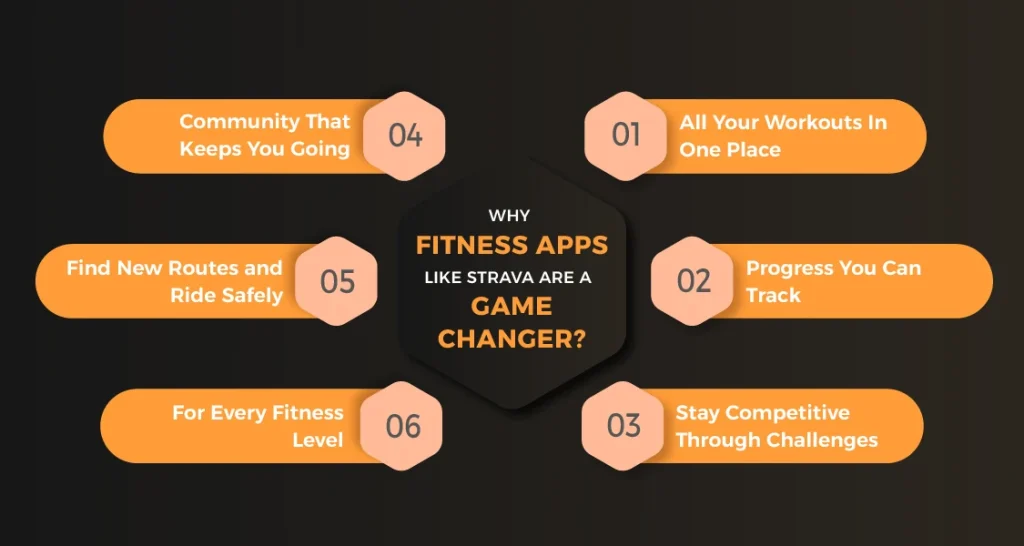
1. All Your Workouts in One Place
A Fitness App Similar to Strava allows you to track nearly every type of physical activity – running, cycling, walking, hiking, and more. You receive real-time results such as pace, overall calories used, heart rate etc. It’s your own digital fitness journal, but smarter and handier.
2. Progress You Can Track
One of the most powerful parts of these apps is how they break down your progress over time. You’re not just logging workouts—you’re seeing trends, tracking improvements, and finding areas of improvements. It makes your fitness journey feel more rewarding and less like guesswork.
3. Stay Competitive Through Challenges
It’s easy to set goals, staying consistent is tough. These apps maintain the motivation level of users by launching monthly challenges, milestones, and achievement badges. As a result users stay consistent and feel a sense of accomplishment. Moreover, these fun competitions rule out the boredom from monotonous routines.
4.Community That Keeps You Going
What truly makes Strava – fitness app development services stand out is the social aspect. You can follow friends, get encouragement, post your workouts, and even join clubs that match your passions. It makes solo workouts a social experience and provides a supportive community that helps you to stay on track.
5. Find New Routes and Ride Safely
Fitness Tracking Apps like Strava also expand your workout zone. You can discover new routes for running or cycling that other people have shared in your location. Most of the apps have safety features such as live tracking, where a person can monitor your location as you train outside.
6. For Every Fitness Level
Whether it’s your first step onto the fitness path or your tenth marathon, apps such as Strava pace themselves to your speed. They assist users in setting achievable goals, maintaining consistency, and making improvements—regardless of where they begin.
Why It Matters for Developers and Businesses?
Fitness apps aren’t only trendy—they’re in a booming industry. With the interest in global health and wellness continuing to grow, the fitness app market is set to rise and will reach more than $30 billion by the year 2030. If you’re considering creating a fitness app, it’s time to get started.
How to Make a Fitness App Like Strava?
Hey, so you want to develop a fitness app like strava that helps people stay active, track their workouts, maybe even build a little fitness community. That needs help from a Mobile app development company and some unique ideas. But here’s the good news: there’s still a lot of space out there if you know how to create the best app. Let’s walk through the step by step guide for the further details:
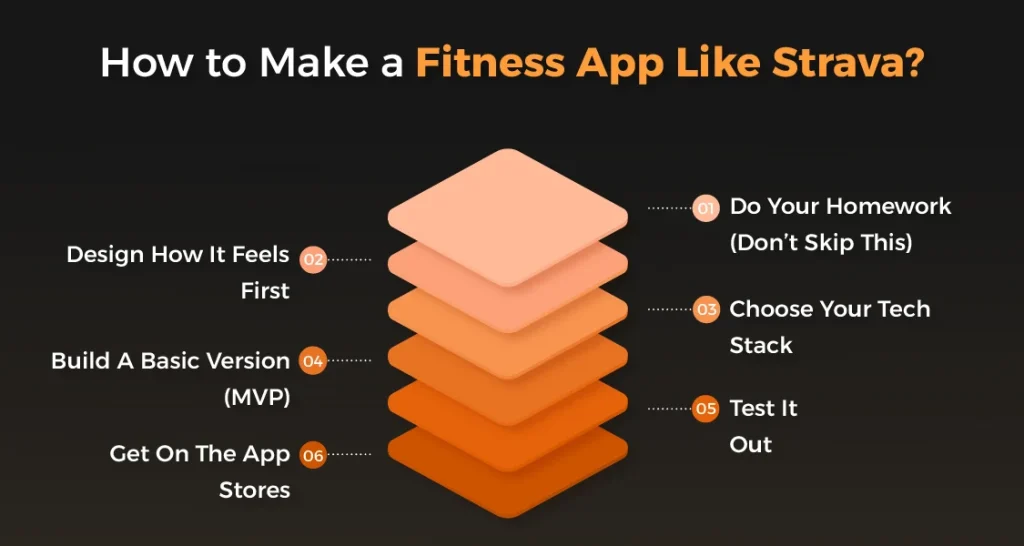
Step 1: Do Your Homework (Don’t Skip This)
Every top-notch product starts with a deep understanding of its utility, what problems it sorts. In this case define your target audience – Are you targeting runners, cyclists, gym lovers, newbies, or maybe niche groups like new moms or seniors?
What’s already out there – Research on apps like Strava, Nike Run Club, Fitbit. What are they doing right and take the inspiration from them
What bugs users – This is where you find your sweet spot.
What makes your app Unique – Maybe it’s smarter tracking, more fun challenges, or a cooler social vibe. Be clear on what are your strengths, weaknesses, opportunities and threats also known as SWOT analysis to know this. This part isn’t just research—it’s laying down the foundation for everything that follows.
Step 2: Design How It Feels First
Before you start typing code, sketch out the user experience. –
Draw out the main screens—home, activity tracker, profile, social feed. Think from the user perspective how they would operate an app. Hire dedicated developers to understand the user behaviour and align the same into your platform.
Keep it simple and lively. Everybody wants apps that are easy to navigate, easy on the eyes, and motivating. Be creative with colors, icons, and visuals that make them want to get moving. Make it easy to use. Can someone record a workout with two clicks? Can they check their progress on their home screen? If your app is fun and friendly to use, people will never delete it.
Step 3: Choose Your Tech Stack
This part can feel a bit challenging, and please consult an experienced team at this stage, but here’s the short and sweet version:
Use React Native or Flutter – This depends on what your requirements are. These are widely used technologies, hence recommended. Consult with a fitness app developer to know the precise technology.
For the backend – go with Node.js or Python—both reliable, scalable, and popular.
Add integrations – Google Maps (for routes), Apple Health or Strava APIs (for fitness data), and Stripe or Razorpay if you’re doing subscriptions.
For storing data, Firebase is great for real-time updates; PostgreSQL works well for structured data. Pick tech that matches your plans and scale—don’t go overboard on complexity on day one.
Step 4: Build a Basic Version (MVP)
Don’t aim to be the next big fitness app. Start small, get feedback, then grow.
What’s essential – GPS tracking, activity summaries (time, distance, pace), add AI in fitness apps, user profiles, and a simple social feed that lets people connect with the world. As users get on the app, you’ll quickly see what features are being used the most—and what you can leave out for now. And that’s pretty much it, just take it step by step, stay flexible, and keep listening to your users. Good luck!
Step 5: Test it out:
Watch how they use the app. Are they getting confused or being excited? Ignoring important stuff? Just see how they are working.
Fix those bugs: Yup, bugs are inevitable. That’s totally okay. The key is fixing them ASAP so your users get a smooth experience.
Ask for honest feedback: Chat with your app development service providers and find out what they’d like to change after user behavior. They’ll often give you the best ideas for what your next steps should be.
Step 6: Get on the app stores:
Launch it on App Store and Google Play. Make sure your listing clearly explains what it does and for whom it is.
Partner with influencers: Reach out to fitness influencers or small creators and ask them to give reviews and promotion.
Show social proof: Ask those early users to share their journey or progress using your app. It really helps people to connect and generate credibility.
Read Also:-How To Develop an MVP: A Step-By-Step Guide
How Much Does It Cost to Develop Fitness App Like Strava?
There’s no one-size-fits-all price tag when it comes to the cost to develop Fitness Tracking App like Strava. The price can range anywhere from $30,000 to $250,000+ depending on the complexity, features, platforms, and the team you hire.
| Category | Details | Estimated Time | Estimated Cost (USD) |
| 1. Planning & Research | Market research, audience definition, competitor analysis, feature roadmap | 2–3 weeks | $2,000 – $5,000 |
| 2. UI/UX Design | Wireframes, interactive prototypes, visual design for mobile and admin panel | 3–5 weeks | $5,000 – $15,000 |
| 3. Frontend Development | React Native or Flutter for cross-platform iOS and Android app development | 8–12 weeks | $15,000 – $40,000 |
| 4. Backend Development | Server logic, user authentication, activity tracking, cloud integration (Node.js/Python) | 10–14 weeks | $20,000 – $50,000 |
| 5. Core MVP Features | GPS tracking, basic stats, user profiles, social feed, history | Built-in above | Included |
| 6. Advanced Features | Challenges, leaderboards, wearable sync, AI insights | 4–6 weeks | $10,000 – $30,000 |
| 7. Admin Panel | Manage users, analytics, reports, content moderation tools | 3–4 weeks | $5,000 – $10,000 |
| 8. Third-Party APIs | Google Maps, Apple HealthKit, Strava API, Stripe/Razorpay | 2–3 weeks | $3,000 – $7,000 |
| 9. Testing & QA | Manual and automated testing, cross-platform performance and functionality testing | 2–4 weeks | $3,000 – $8,000 |
| 10. Deployment | Launching it on App Store and Play Store | 1 week | $500 – $1,000 |
| 11. Marketing & Launch | Social media campaigns, influencer partnerships, launch strategy, content marketing | 4–6 weeks | $5,000 – $20,000+ |
| 12. Post-Launch Support | Bug fixes, updates, performance optimization, feedback-based changes | Ongoing | $2,000 – $8,000/month |
Optional Add-ons (Advanced or Post-MVP)
| Feature / Add-On | Purpose | Estimated Cost (USD) |
| Wearable device integration | Apple Watch, Fitbit, Garmin syncing | $5,000 – $15,000 |
| Cost to develop an AI Fitness App like Strava (Integration) | For personalized workouts, trend analysis | $10,000 – $25,000+ |
| Gamification | Badges, streaks, rewards | $3,000 – $10,000 |
| Multilingual support | For a global audience | $2,000 – $8,000 per language |
| Real-time audio feedback | Voice cues during workouts | $3,000 – $7,000 |
| GDPR / HIPAA compliance | Data protection and legal compliance | $3,000 – $10,000+ |
Estimated Total Cost by App Complexity
| App Type | Features | Total Estimated Cost (USD) | Timeline |
| Basic MVP | Core tracking, basic social features | $30,000 – $60,000 | 3–4 months |
| Mid-Level App | Includes admin panel, challenges, wearable integration | $60,000 – $120,000 | 4–6 months |
| Full Strava-Like App | Advanced analytics, AI, global support | $120,000 – $250,000+ | 6–9+ months |
Ongoing Costs After Launch
| Service | Details | Estimated Monthly Cost (USD) |
| App maintenance and updates | Bug fixes, OS updates, feature rollouts | $2,000 – $8,000/month |
| Cloud hosting and storage | AWS, Firebase, or Google Cloud | $500 – $2,000/month |
| Customer support | In-app or email support | $500 – $1,500/month |
| Marketing | Continuous growth efforts | $2,000 – $10,000+ per month |
Conclusion
Hiring the best fitness app development company like Helpful Insight to develop your fitness tracking app can be a big step for achieving new heights. HIPL has the reputation of building the best fitness apps known worldwide. They are known for developing tech savvy, adaptable, and easy-to-use apps that meet and exceed clients requirements.
Developing a strava mobile app isn’t only about programming an app it’s about cultivating an experience that encourages, connects, and inspires masses to live healthier. Helpful Insight is with you on every step from monitoring activities and examining performance to forming an inspiring fitness community with potential is thrilling and limitless.
Frequently Asked Questions (FAQs)
Ans This can hugely depend upon what you are asking in terms of design and complexity, the development can be around 3 to 9 months. A basic MVP can be developed in 8–12 weeks, while a full-scale app could take 7-8 months.
Ans. Yes! Following are the common practices that can help you generate money:
- Freemium (basic features free, premium features via subscription)
- Set In-app purchases like some special features
- Ads (if implemented carefully). We do not encourage this but if it fits in your business model the you can try
- Partnerships and sponsored content.
Ans. Start with these features trending in fitness app 2025:
- GPS-based activity tracking and for sharing locations within the app
- AI in fitness apps – It makes the workout smarter and more intuitive.
- User profiles and login
- Workout history and user analytics
- Basic analytics (pace, distance, duration)
- Social sharing or community feed
You can always expand later with advanced analytics, wearable integration like making it watch friendly, or gamified challenges.






